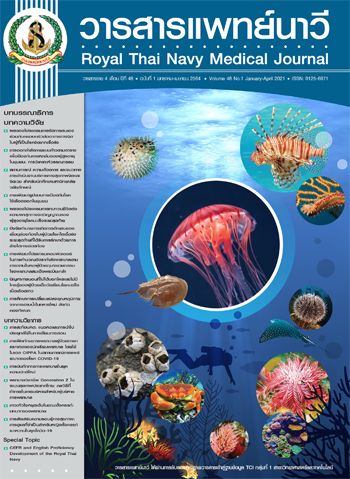The Study of Body Temperature Change from Taking a Shower among New RTA Recruits
Main Article Content
Abstract
Daytime showering was an additional measure to increase heat-related illness prevention effectiveness in the RTA recruit training program, but the appropriate duration of taking a shower was doubtful. This retrospective cohort study aimed to compare the body temperature change from different shower duration in the RTA recruit training program. The data were taken from 277 conscripts of three training units. The length of time when taking a shower was recorded from entering to leaving the bathroom and the change of body temperature was calculated from the pre-bath temperature minus the post-bath temperature which was measured by a thermometer. The difference in temperature change was analyzed from the duration of showering.
The results showed that the samples were all male and 93.50% of them were 21 - 22 years old and 68.23% of the subject had normal body mass index (BMI). Any shower duration decreased the body temperature. The maximum temperature change was 0.45 ± 0.14 Celsius when taking a shower for thirty-five minutes, and minimum temperature change was 0.03 ± 0.20 Celsius in five minutes of taking a shower. Every duration of showers demonstrated a significant statistical difference of body temperature change (p < 0.05) except for the 5 - 10 minutes and 20 - 25 - 30 minutes of showering. Lastly, shower duration affects body temperature change so further study needs to show a clear result for proper application.
Article Details

This work is licensed under a Creative Commons Attribution-NonCommercial-NoDerivatives 4.0 International License.
References
Health Promotion and Prevention Medicine Division. The Royal Thai Army Medical Announcement: recommendation for prevention and surveillance and first aids and treatment of heat related injury. In: corps TRTAM, editor. Bangkok: Health Promotion and Preventive Medicine Division; 2013. (in Thai).
Agency USEP. Climate change indicators: heat-related deaths 2016. [Internet]. [cited 2021 February 1]. Available from: https://www.epa.gov/climate-indicators/climate-change-indicators-heat-related-deaths.
Thepnarin N, Buapetch A, Isaramalai S. Development of heat injury prevention program among the Royal Thai Army recruits. Songklanagarind Journal of Nursing 2017;37(4):69-82. (in Thai).
Phivgategaew S, Chomchai S, Dumavibhat N, Sujirarat D. Comparison of initial BMI in moderate to severe heat-related illness among Royal Thai Navy Task Force Trainees. Royal Thai Navy Medical Journal 2019;46(1):49-65. (in Thai).
Hattachot P. Knowledge management and technology transfer for the innovation RTA heat stroke mobile application for heat related illnesses prevention among new army conscripts during the basic training. National Research Council of Thailand; 2019. (in Thai).
Health Promotion and Prevention Medicine Division. Heat related injury surveillance and first aid (medical staff) handbook. Bangkok: The Royal Thai Army Medical; 2012. (in Thai).
McDermott BP, Casa DJ, Ganio MS, Lopez RM, Yeargin SW, Armstrong LE, et al. Acute whole-body cooling for exercise-induced hyperthermia: a systematic review. J Athl Train 2009;44(1):84-93.
Deepreecha K, Seehabun W, Saengdidtha B. 100 The effectiveness of daytime bath among new conscripts in a training unit for heat injury prevention 2018. Occupational and Environmental Medicine 2018;75(Suppl 2):A502-3.
Juliff LE, Halson SL, Bonetti DL, Versey NG, Driller MW, Peiffer JJ. Influence of contrast shower and water immersion on recovery in elite netballers. J Strength Cond Res 2014;28(8):2353-8.
Truxton TT, Miller KC. Can temperate-water immersion effectively reduce rectal temperature in exertional heat stroke? A critically appraised topic. J Sport Rehabil 2017;26(5):447-51.
Tan PM, Teo EY, Ali NB, Ang BC, Iskandar I, Law LY, et al. Evaluation of various cooling systems after exercise-induced hyperthermia. J Athl Train 2017;52(2):108-16.
Butts CL, McDermott BP, Buening BJ, Bonacci JA, Ganio MS, Adams JD, et al. Physiologic and perceptual responses to cold-shower cooling after exercise-induced hyperthermia. J Athl Train 2016;51(3):252-7.
Luhring KE, Butts CL, Smith CR, Bonacci JA, Ylanan RC, Ganio MS, et al. Cooling effectiveness of a modified cold-water immersion method after exercise-induced hyperthermia. J Athl Train 2016;51(11):946-51.
DeMartini JK, Ranalli GF, Casa DJ, Lopez RM, Ganio MS, Stearns RL, et al. Comparison of body cooling methods on physiological and perceptual measures of mildly hyperthermic athletes. J Strength Cond Res 2011;25(8):2065-74.
Nye EA, Edler JR, Eberman LE, Games KE. Optimizing cold-water immersion for exercise-induced hyperthermia: an evidence-based paper. J Athl Train 2016;51(6):500-1.
Legrand A, Schütz KE, Tucker CB. Using water to cool cattle: behavioral and physiological changes associated with voluntary use of cow showers. J Dairy Sci 2011;94(7):3376-86.
Ajjimaporn A, Chaunchaiyakul R, Pitsamai S, Widjaja W. Effect of cold shower on recovery from high-intensity cycling in the heat. J Strength Cond Res 2019;33(8):2233-40.
Dupont WD, Plummer WD. Power and sample size calculations: a review and computer program. Control Clin Trials 1990;11(2):116-28.
Stephens JM, Sharpe K, Gore C, Miller J, Slater GJ, Versey N, et al. Core temperature responses to cold-water immersion recovery: a pooled-data analysis. Int J Sports Physiol Perform 2018;13(7):917-25.
Glen P, McGinn K, McGinn R. Restoration of thermoregulation after exercise. J Appl Physiol 2017;122:933-44.


